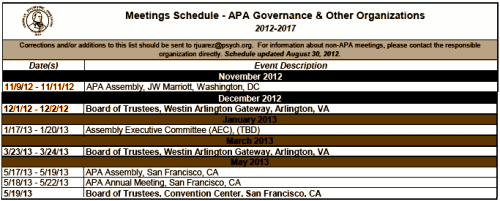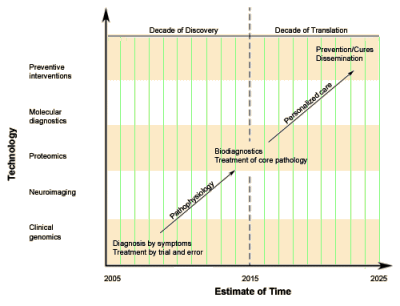
[click image for full schedule]
At one of those meetings in the next few months, the DSM-5 is scheduled to be presented to the American Psychiatric Association’s Board of Trustees for final approval before going to print for the scheduled launch in May 2013. The web site, which hasn’t been touched in several months, still begins with:
Publication of the fifth edition of Diagnostic and Statistical Manual of Mental Disorders [DSM-5] in May 2013 will mark one of the most anticipated events in the mental health field.
 The results of the Field Trials remain unpublished and the once ubiquitous articles in the press and psychiatric newsletters about the DSM-5 have disappeared from sight. About the only things about psychiatry are the billion dollar settlements with the pharmaceutical companies for false advertising and other sins [GSK‘s Paxil & Wellbutrin, Janssen‘s Risperdal, Abbott‘s Depakote]. Even Dr. Insel’s NIMH blog this month is about his new plan for yet another classification [RDoC], referring to the DSM diagnoses as "fictive categories" [Words Matter]. So the DSM-5 seems to have moved from "one of the most anticipated events in the mental health field" into the realm of New Coke and the Segway – previous highly anticipated non-events.
The results of the Field Trials remain unpublished and the once ubiquitous articles in the press and psychiatric newsletters about the DSM-5 have disappeared from sight. About the only things about psychiatry are the billion dollar settlements with the pharmaceutical companies for false advertising and other sins [GSK‘s Paxil & Wellbutrin, Janssen‘s Risperdal, Abbott‘s Depakote]. Even Dr. Insel’s NIMH blog this month is about his new plan for yet another classification [RDoC], referring to the DSM diagnoses as "fictive categories" [Words Matter]. So the DSM-5 seems to have moved from "one of the most anticipated events in the mental health field" into the realm of New Coke and the Segway – previous highly anticipated non-events.
Perhaps it’s premature to do an autopsy on something yet unborn, but barring divine intervention, I’m on pretty solid ground. The DSM-5 is an anachronism prior to its release. It was conceived to be the launching of a psychiatry grounded in biomarkers and neuroscience – the realization of the dreams from St. Louis in the 1970s. The Task Force began with a book [A Research Agenda for DSM-5] and an elaborate series of research planning conferences:
Dr. Insel of the NIMH was on board with his 2005 Psychiatry as a Clinical Neuroscience Discipline [complete with timetable]:

But as it turned out, the psychiatry of 2004 hardy needs to be enshrined. As mentioned here ad nauseum, it just didn’t work out like they thought it would. In retrospect, it was grandiose and risky to build their tower on something that only might be there when they arrived in the future, because it wasn’t there, and they hadn’t planned on that. And it was even riskier not to hedge their bets by doing the job they were assigned – revising the manual we had, smoothing out the rough spots [of which there were many]. Without the anticipated bioscience or any practical work done on the DSM-IV categories that needed work, they then  complicated matters by adding a bunch of quirky things that were appropriately attacked from all sides. My fear is that the APA will press ahead with this DSM-5 which will be released to a tepid [at best] audience, but will then become like the Albatross hung around the neck of the sailor in Coleridge’s Rime of the Ancient Mariner – a reminder of the arrogant time in which it was conceived. Dr. Spitzer’s success with the DSM-III was probably that he found a solution to the dichotomy between mind psychology and brain biology. Following ancient advice about the horns of a dilemma, Dr. Spitzer went "between the horns," coming up with a third possibility: descriptive but reliable. The DSM-5 Task Force committed themselves prematurely, and absent the hoped-for biological substrate, it ended up peculiar and unreliable.
complicated matters by adding a bunch of quirky things that were appropriately attacked from all sides. My fear is that the APA will press ahead with this DSM-5 which will be released to a tepid [at best] audience, but will then become like the Albatross hung around the neck of the sailor in Coleridge’s Rime of the Ancient Mariner – a reminder of the arrogant time in which it was conceived. Dr. Spitzer’s success with the DSM-III was probably that he found a solution to the dichotomy between mind psychology and brain biology. Following ancient advice about the horns of a dilemma, Dr. Spitzer went "between the horns," coming up with a third possibility: descriptive but reliable. The DSM-5 Task Force committed themselves prematurely, and absent the hoped-for biological substrate, it ended up peculiar and unreliable.
 complicated matters by adding a bunch of quirky things that were appropriately attacked from all sides. My fear is that the APA will press ahead with this DSM-5 which will be released to a tepid [at best] audience, but will then become like the Albatross hung around the neck of the sailor in Coleridge’s Rime of the Ancient Mariner – a reminder of the arrogant time in which it was conceived. Dr. Spitzer’s success with the DSM-III was probably that he found a solution to the dichotomy between mind psychology and brain biology. Following ancient advice about the horns of a dilemma, Dr. Spitzer went "between the horns," coming up with a third possibility: descriptive but reliable. The DSM-5 Task Force committed themselves prematurely, and absent the hoped-for biological substrate, it ended up peculiar and unreliable.
complicated matters by adding a bunch of quirky things that were appropriately attacked from all sides. My fear is that the APA will press ahead with this DSM-5 which will be released to a tepid [at best] audience, but will then become like the Albatross hung around the neck of the sailor in Coleridge’s Rime of the Ancient Mariner – a reminder of the arrogant time in which it was conceived. Dr. Spitzer’s success with the DSM-III was probably that he found a solution to the dichotomy between mind psychology and brain biology. Following ancient advice about the horns of a dilemma, Dr. Spitzer went "between the horns," coming up with a third possibility: descriptive but reliable. The DSM-5 Task Force committed themselves prematurely, and absent the hoped-for biological substrate, it ended up peculiar and unreliable.
Incredibly, David Healy just appeared at an APA convention airing his “psychiatry committing professional suicide” trope and had a respectful hearing http://healthland.time.com/2012/10/05/psychiatrist-contends-the-field-is-committing-professional-suicide/